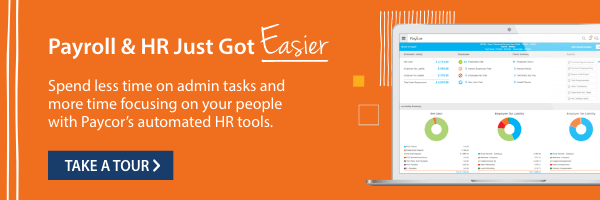AI has already revolutionized certain industries, and these tools are only growing. The job description of an HR leader is already changing. Over the next few years, we can expect GenAI to have a larger and larger impact on the nature of work itself.
There are countless AI-powered chatbots out there, like ChatGPT, Gemini, and Copilot, just to name a few. And those are just the free ones! There’s some controversy about AI, but this powerful technology isn’t going away. On the contrary, it’s growing faster and faster – in terms of both its capabilities and popularity. Whether or not you’re using AI tools, it’s safe to assume your competitors are leveraging chatbot technology for HR tasks.
In this article, we’ll compare some of the more popular GenAI tools with tips and tricks HR leaders can use for employee engagement programs, drafting emails, the hiring process, career development plans, and more.
What is GenAI?
If you’re just starting to learn about AI tools, this is for you! Let’s define a few key terms you might hear in reference to this technology:
- GenAI stands for Generative Artificial Intelligence. GenAI tools like ChatGPT, Gemini, and Dall-E can generate content based on prompts. That content could take the form of images, texts, tables, and so on.
- LLM means “large language model.” These tools are text-based, and function like super-charged chatbots.
- Prompt engineering is the act of crafting prompts an AI tool can understand and respond to effectively. Prompt engineering lets users make the most out of their interactions with AI.
If you’re using GenAI at work, make sure you check with your legal team before feeding it any company data. If your company has a subscription to a certain tool, you might be able to share sensitive data and trust it will remain private. But if you’re chatting with the free online version of an LLM, anything you write might be shared with its parent company.
Comparison of GenAI Tools
Every GenAI tool has different strengths and limitations. If your company policy permits it, you can switch between which LLMs you use for various HR tasks. You might use one chatbot to write interview questions, another to plan employee surveys, and yet another to analyze real-time insights into your team’s needs.
ChatGPT
Best For: Internal communications, brainstorming talking points, creating checklists
Background: ChatGPT is older than you might think. OpenAI first released GPT-2 in February 2019. At the time, it attracted interest in tech circles but not among the general public. ChatGPT gained significant traction in November 2022, quickly becoming a household name. Today, it’s the subject of great interest and debate. As the first text-based AI software to get such widespread attention, it’s still one of the most popular tools available.
Strengths: ChatGPT can understand, generate, and respond to human language with remarkable accuracy. It’s very good at formatting content and generating ideas based on prompts. The paid version, ChatGPT Plus, can access current information through various plug-ins, meaning it can help with research. Users can save different conversations and train the tool to remember their preferences.
By training ChatGPT to speak in a unified company voice, HR can take internal communications to the next level. You can use it for anything from drafting emails to brainstorming interview questions to planning an onboarding process.
Limitations: The free version has knowledge of information up through September 2021, but it can’t search the internet in real time. Like most other LLMs, ChatGPT sometimes hallucinates. In other words, it confidently provides inaccurate information. It’s very important to fact-check any content ChatGPT produces.
Examples:
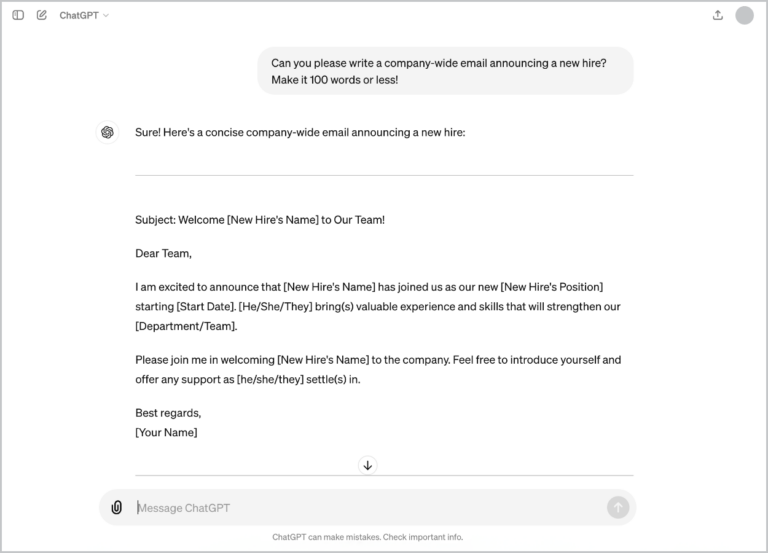
Gemini
Best For: Employee engagement surveys, career planning, generating lists
Background: Gemini is Google’s GenAI chatbot. Different iterations of this tool, once called Bard, have been available for several years. It’s been the subject of more than one controversy, sometimes making divisive political statements. Maybe because of that attention, this software gets updated often, and Google continues to roll out new features. (By the time you’re reading this article, it might have even more than those mentioned here!)
Strengths: Gemini’s word choice is complex and engaging. It can be more poetic than other LLMs, which is helpful in some situations. Like ChatGPT, you can save past conversations and train Gemini to remember your preferences. It’s especially good at generating ideas and reframing content for different platforms. Gemini can access and process some information through Google Search and can read links the user provides.
Gemini can be incredibly useful in human resource management because its output is easy and fun to read. This is especially useful for employee engagement. For instance, it can help HR craft questions for employee engagement surveys, brainstorm career development plans, and give you real-time insights into your team’s needs. You could even feed it common employee queries and build out a FAQ section for your employee handbook! The options are nearly endless.
Limitations: Gemini can’t access the internet directly, so it’s not a great tool for research. However, it’s trained on real-world information, so it can provide some context when necessary. None of the data you share with Gemini is secure; be prepared for its developers to read every conversation. As a relatively new tool, it sometimes develops glitches. It can also hallucinate information, so make sure to fact-check all its output!
Examples:
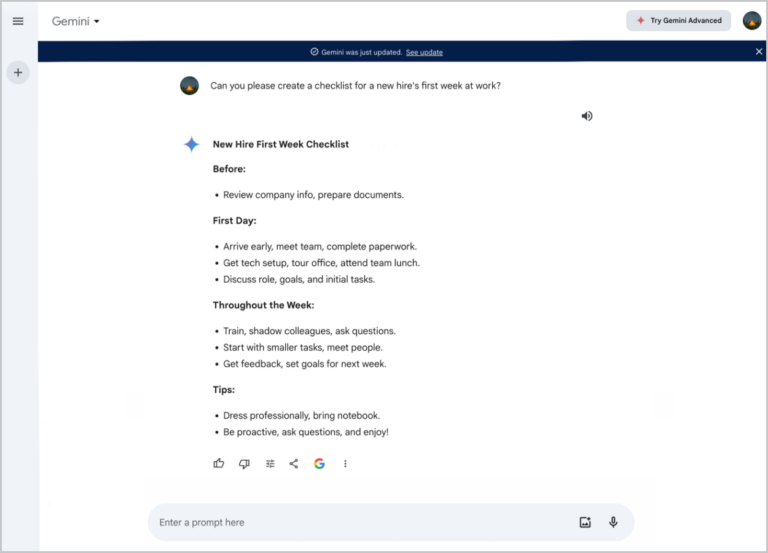
Copilot
Best For: Research, writing company policies, organizing data
Background: Microsoft Copilot, also called Bing Chat, was introduced in early 2023. This suite of tools is built on OpenAI’s technology but has different capabilities than ChatGPT. Microsoft describes Copilot as a “digital assistant” that can integrate tools like your calendar, chat threads, and so on.
Strengths: Unlike some other GenAI tools, Copilot can search the web in real time to answer HR queries. It also provides links to citations, making it a powerful research partner. Its writing style is very straightforward, which is important for HR tasks like communicating policies to your team. Copilot is a great way to compile and organize hard data.
Limitations: Like other tools, Copilot sometimes hallucinates information, so it’s important to double-check its work. Its straightforward tone isn’t always right for emotionally sensitive subject matter like emails about conflict resolution.
Examples:
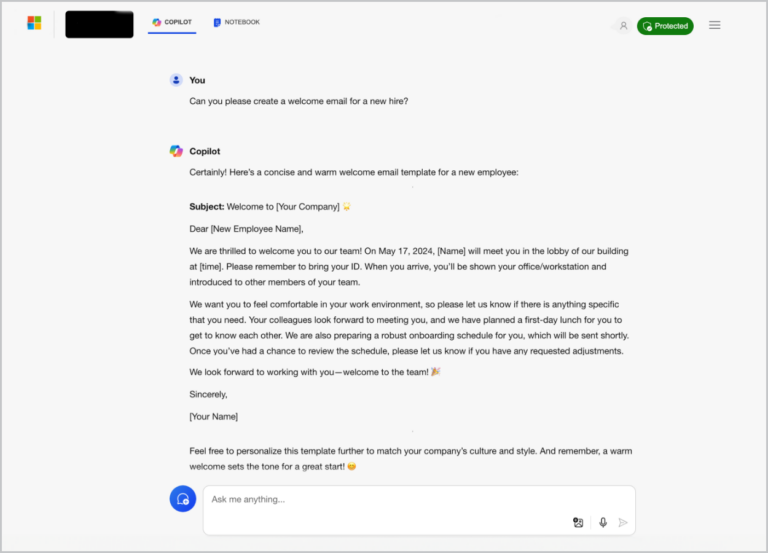
Claude
Best For: Writing emails, how-to guides, and announcements
Background: Claude comes from Anthropic, a much smaller company than Google or Microsoft. Unlike those tech giants, AI is Anthropic’s sole focus. The first version of Claude was released in March 2023.
Strengths: Tech journalists call Claude the “most human-like” AI-powered chatbot when compared to other GenAI tools. It’s an easy way to write interpersonal communications, like emails or company-wide announcements.
Limitations: The free version of Claude has no access to the internet – it can’t even read URLs the user provides directly. You also can’t save conversations, meaning you have to give it new parameters every time you start a chat.
Examples:
[Note for Design: see Screenshot_Claude_R1 in WZ]
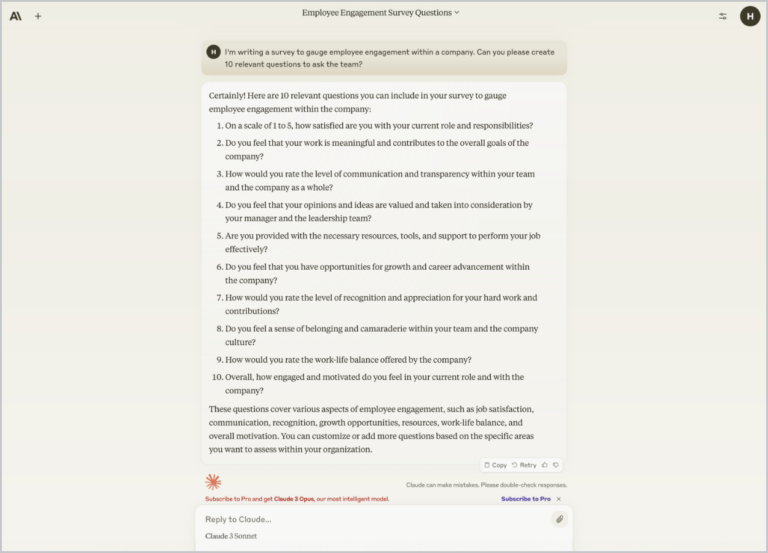
AI-Powered Tools, Purpose-Built for HR
Paycor’s suite of HR solutions includes powerful AI software, designed to empower leaders. These tools can streamline countless HR processes, helping you support employees from hire to retire. Paycor Smart Sourcing reduces time-to-hire by writing job descriptions, expands your talent pool by sourcing active and passive candidates, and ties into your DE&I strategy by reducing implicit bias. Once employees join your team, Paycor Pulse Surveys gather and analyze their feedback, giving you real insights into the employee experience. As your company grows, our Talent Development Software helps leaders craft meaningful performance reviews to support people in every stage of their careers.
